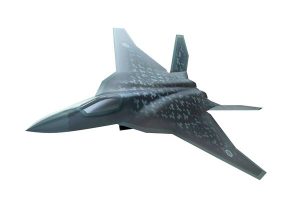The Japanese government is considering choosing British aerospace and defense contractor BAE Systems to support prime contractor Mitsubishi Heavy Industries (MHI) in developing the F-X next-generation fighter aircraft for the Japan Air Self-Defense Force (JASDF), informed sources said.
The move comes as a surprise to many because Japan’s Ministry of Defense (MoD) had already selected U.S. company Lockheed Martin as the only possible main partner for the F-X development project in December 2020. At that time, the ministry said Lockheed Martin was selected as “F-X Integration Support Company candidate” because it has considerable experience in developing fifth-generation fighters – the F-22 and F-35 – compared with the other two candidates, BAE Systems and Boeing.
In addition, considering the strengthening of the Japan-U.S. alliance in the post-war period, it is extremely rare for Tokyo to look to Britain, rather than the United States, for a major defense project. The F-X program is one of the largest national projects in decades, with the total project cost expected to amount to more than one trillion Japanese yen ($7.7 billion).
What is behind this unusual case?
“Lockheed Martin was not so enthusiastic about developing Japan’s next-generation fighter,” a ruling Liberal Democratic Party lawmaker, who is a defense policy wonk, said, speaking on condition of anonymity.
“Moreover, for the U.S., the timing of the development of Japan’s next fighter is off because the U.S. has already developed F-35s,” the lawmaker said, adding that this seems to be the biggest reason for Lockheed Martin’s unenthusiastic attitude.
Instead, the U.S. Air Force is pushing ahead with its ambitious Next Generation Air Dominance (NGAD) future fighter program. This sixth-generation fighter aircraft is expected to replace the service’s Lockheed Martin F-22 Raptor fleet, starting in the 2030s. A full-scale flight demonstrator already flew for the first time in 2020.
Meanwhile, the U.K.-led Tempest, which is being developed under the Future Combat Air System (FCAS) program, and the Japanese F-X program have similar timelines, being slated to enter operational service from the mid-2030s. That enables the U.K. and Japan to pursue joint technologies for their fighters.
Japan and the U.K. have already decided to collaborate on engine parts and sensor technology for both the Tempest and F-X future combat aircraft programs.
The U.K. government has promised to give Japan a higher degree of freedom to make modifications and upgrades of future aircraft, which would be handled after deployment.
In contrast, the U.S. tends to prevent other countries, even allies, from attempting to reverse engineer parts such as radar and sensor components, by putting most sensitive aircraft technologies in a “black box.” This also has been making it difficult for Tokyo and Washington to coordinate work in the F-X project.
In their talks May 5 in London, Prime Minister Kishida Fumio and his British counterpart, Boris Johnson, affirmed that their countries will agree on an overview of a joint development program by year-end, with the defense authorities of the two countries hammering out the specifics of expanded cooperation.
At the same time, Defense Minister Kishi Nobuo was busy laying the groundwork for Japan-U.K. cooperation in Washington. He met U.S. Secretary of Defense Lloyd Austin and explained the expansion of the military-technology partnership between London and Tokyo, two U.S. allies. The Japanese government said Austin understood the latest development on Japan’s F-X project and welcomed it.
As if the MoD anticipated today’s situation, the ministry had been cautious about saying that Lockheed Martin is already a “partner” in the F-X program, preferring to refer to it as a “partner candidate” until MHI and the U.S. company finalize the details of the agreement. Now MHI is set to finalize the terms of a deal with the British company instead.
Looking back, in the mid-1980s Japan was interested in developing an indigenous fighter aircraft to replace its aging fleet of F-1 fighters. However, the United States wanted Tokyo to purchase an off-the-shelf U.S. fighter. The two sides later agreed on the co-development of the F-2, which is based the F-16 Fighting Falcon.
Under the F-X program, Japan is aiming to develop and build a next-generation fighter aircraft on its own as much as possible. For this reason, it has been negotiating advantageous contract terms with Lockheed Martin, a process which apparently has been not going well so far.
Still, to ensure interoperability between the JSDF and U.S. Forces, the two nations will explore collaboration in areas such as datalinks and unmanned aerial vehicles (UAVs), widely known as attritable “loyal wingmen,” which team up with piloted aircraft for combat support.
In the U.K., the Tempest is being developed under the Future Combat Air System (FCAS) program, undertaken by the Team Tempest industry partners of BAE Systems, Leonardo UK, MBDA UK, and Rolls-Royce.
Meanwhile, in Japan the F-X fighter aircraft program is being led by MHI as the single prime contractor, together with seven subcontractors, namely IHI, Kawasaki Heavy Industries (KHI), SUBARU, Toshiba, NEC, Fujitsu, and Mitsubishi Electric. The future fighter jet is expected to replace the JASDF’s MHI F-2 fighter aircraft staring from around 2035.

































